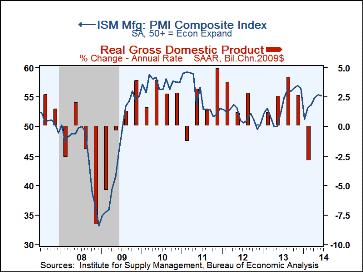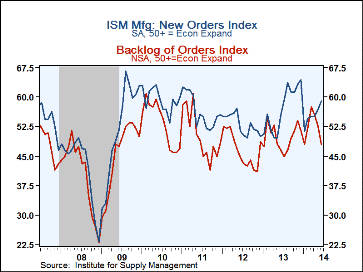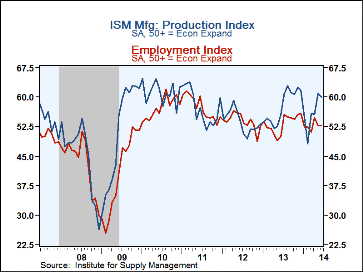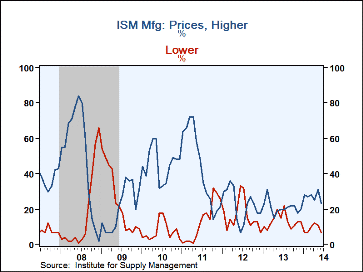 Global| Jul 01 2014
Global| Jul 01 2014U.S. ISM Index Holds Steady; Prices Slip
by:Tom Moeller
|in:Economy in Brief
Summary
The Composite Index of Manufacturing Sector Activity from the Institute for Supply Management held fairly steady at 55.3 during June versus an unrevised 55.4 in May. The reading remained nearly the highest since December but was below [...]
The Composite Index of Manufacturing Sector Activity from the Institute for Supply Management held fairly steady at 55.3 during June versus an unrevised 55.4 in May. The reading remained nearly the highest since December but was below the peak of 57.0 this past November. It was just shy of consensus expectations for 55.8 as measured by the Action Economics Forecast Survey. Any figure above 50 indicates an increasing level of factory sector activity. During the last ten years, there has been a 76% correlation between the ISM index and the q/q change in real GDP.
Movement amongst the component series last month was mixed. The new orders index (58.9) improved to its highest level in six months. The employment reading was steady at 52.8. During the last ten years there has been an 88% correlation between the employment index and the m/m change in factory payrolls. Also steady was the inventories series at 53.0, where its roughly been for five months. To the downside were the production (60.0) and supplier delivery (51.9) indexes, the latter indicating the quickest delivery speeds in twelve months.
The export order series (54.5) fell modestly and was stable at the year-ago level. The import index (57.0) rose and reversed most of its May decline. Order backlogs (48.0) fell sharply to the lowest level since last August.
The prices paid index series (58.0) fell slightly and remained in the range of the last six months. A lessened twenty three percent of firms raised prices and an easier seven percent lowered them. During the last ten years, there has been a 67% correlation between the index and the m/m change in the intermediate producer price index.
The figures from the Institute For Supply Management (ISM) are diffusion indexes and can be found in Haver's USECON database. The expectations number is in the AS1REPNA database.
Accommodative Monetary Policy: Savior or Saboteur? from the Federal Reserve Bank of San Francisco is available here.
| ISM Mfg | Jun | May | Apr | Jun'13 | 2013 | 2012 | 2011 |
|---|---|---|---|---|---|---|---|
| Composite Index | 55.3 | 55.4 | 54.9 | 52.5 | 53.9 | 51.8 | 55.2 |
| New Orders | 58.9 | 56.9 | 55.1 | 55.7 | 57.2 | 53.1 | 56.4 |
| Production | 60.0 | 61.0 | 55.7 | 55.7 | 57.7 | 53.8 | 57.4 |
| Employment | 52.8 | 52.8 | 54.7 | 50.0 | 53.2 | 53.8 | 57.4 |
| Supplier Deliveries | 51.9 | 53.2 | 55.9 | 50.4 | 51.9 | 50.0 | 54.7 |
| Inventories | 53.0 | 53.0 | 53.0 | 50.5 | 49.4 | 48.2 | 50.1 |
| Prices Paid Index (NSA) | 58.0 | 60.0 | 56.5 | 52.5 | 53.8 | 53.2 | 65.2 |
Tom Moeller
AuthorMore in Author Profile »Prior to joining Haver Analytics in 2000, Mr. Moeller worked as the Economist at Chancellor Capital Management from 1985 to 1999. There, he developed comprehensive economic forecasts and interpreted economic data for equity and fixed income portfolio managers. Also at Chancellor, Mr. Moeller worked as an equity analyst and was responsible for researching and rating companies in the economically sensitive automobile and housing industries for investment in Chancellor’s equity portfolio. Prior to joining Chancellor, Mr. Moeller was an Economist at Citibank from 1979 to 1984. He also analyzed pricing behavior in the metals industry for the Council on Wage and Price Stability in Washington, D.C. In 1999, Mr. Moeller received the award for most accurate forecast from the Forecasters' Club of New York. From 1990 to 1992 he was President of the New York Association for Business Economists. Mr. Moeller earned an M.B.A. in Finance from Fordham University, where he graduated in 1987. He holds a Bachelor of Arts in Economics from George Washington University.










